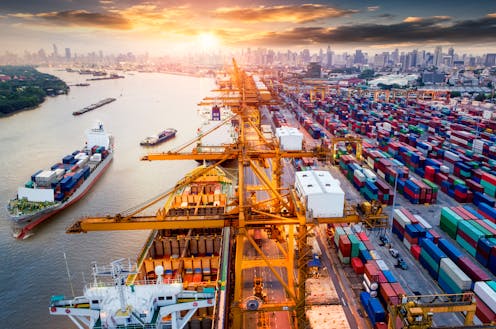What if carbon border taxes applied to all carbon – fossil fuels, too?
- Written by Joonha Kim, Graduate fellow, Baker Institute, Rice University

The European Union is embarking on an experiment[1] that will expand its climate policies to imports for the first time. It’s called a carbon border adjustment[2], and it aims to level the playing field for the EU’s domestic producers by taxing energy-intensive imports like steel and cement that are high in greenhouse gas emissions but aren’t already covered by climate policies in their home countries.
If the border adjustment works as planned, it could encourage the spread of climate policies around the world. But the EU plan, as well as most attempts to evaluate the impact of such policies, is missing an important source of cross-border carbon flows: trade in fossil fuels themselves.
As energy[3] analysts[4], we decided to take a closer look at what including fossil fuels would mean.
In a newly released paper[5], we analyzed the impact and found that including fossil fuels in carbon border adjustments would significantly alter the balance of cross-border carbon flows.
For example, China is a major exporter of carbon-intensive manufactured goods, and its industries will face higher costs under the EU border adjustment if China doesn’t set sufficient climate policies for those industries. But when fossil fuels are considered, China becomes a net carbon importer, so setting its own comprehensive border adjustment could be to its energy producers’ benefit.
The U.S., on the other hand, could see harm to its domestic fuel producers if other countries imposed carbon border adjustments on fossil fuels. But the U.S. would still be a net carbon importer, and adding a border adjustment could help its domestic manufacturers.
What is a carbon border adjustment?
Carbon border adjustments[6] are trade policies designed to avoid “carbon leakage[7]” – the phenomenon in which manufacturers relocate their production to other countries to get around environmental regulations.
The idea is to impose a carbon “tax” on imports that is commensurate with the costs domestic companies face related to a country’s climate policy. The carbon border adjustment is imposed on imports from countries that do not have similar climate policies. In addition, countries can give rebates to exports to ensure domestic manufacturers remain competitive in the global market.
This is all still in the future. The EU plan phases in starting in 2023 but currently isn’t scheduled to fully go into effect until 2026[8]. However, other countries are closely watching as they consider their own policies, including some members of the U.S. Congress who are considering carbon border adjustment legislation[9].
Capturing all cross-border carbon flows
One issue is that current discussions of carbon border taxes focus on “embodied” carbon – the carbon associated with the production of a good. For example, the EU proposal covers cement, aluminum, fertilizers, power generation, iron and steel.
But a comprehensive border adjustment, in theory, should seek to address all cross-border carbon flows. All the major analyses[10] to date, however, leave out the carbon content of fossil fuels trade, which we refer to as “explicit” carbon.
In our analysis[11], we show that when only manufactured goods are considered, the U.S. and EU are portrayed as carbon importers because of their “embodied” carbon balance – they import a lot of high-carbon manufactured goods – while China is portrayed as a carbon exporter. That changes when fossil fuels are included.
The impact of including fossil fuels
By assessing the impact of a carbon border adjustment based only on embodied carbon flows, those involving manufactured goods, policymakers are missing a significant part of total carbon traded across their borders – in many cases, the largest part.
In the EU, our findings largely reinforce the current motivation behind a carbon border adjustment, since the bloc is an importer of both explicit carbon and embodied carbon.
For the U.S., however, the results are mixed. A carbon border adjustment could protect domestic manufacturers but harm the international competitiveness of domestic fossil fuels, and at a time when Russia’s invasion of Ukraine is placing renewed importance on the U.S. as a global energy supplier[12].
The Chinese economy, as an exporter of embodied carbon in manufactured goods, would suffer if its trading partners imposed a carbon border adjustment on China’s products. On the other hand, a Chinese domestic border adjustment could benefit Chinese domestic energy producers at the expense of foreign competitors who fail to adopt similar policies.
Interestingly, our analysis[13] suggests that, by including explicit carbon flows, the U.S., EU and China are all net importers of carbon. All three key players could be on the same side of the discussion, which could improve the prospects for future climate negotiations – if all parties recognize their common interests.
References
- ^ embarking on an experiment (crsreports.congress.gov)
- ^ carbon border adjustment (www.consilium.europa.eu)
- ^ energy (www.bakerinstitute.org)
- ^ analysts (www.bakerinstitute.org)
- ^ newly released paper (www.bakerinstitute.org)
- ^ Carbon border adjustments (www.rff.org)
- ^ carbon leakage (clear.ucdavis.edu)
- ^ until 2026 (ccsi.columbia.edu)
- ^ considering carbon border adjustment legislation (www.whitehouse.senate.gov)
- ^ major analyses (www.oecd.org)
- ^ our analysis (www.bakerinstitute.org)
- ^ global energy supplier (apnews.com)
- ^ our analysis (www.bakerinstitute.org)







